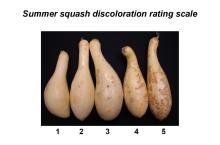Product Description
Maturity and Quality
Summer squashes (soft-rind) are consumed at a range of physiological maturities but are defined as immature fruits of the diverse Cucurbitaceae family. Depending on cultivar and temperature, the time from flowering to harvest may be 45 to 60 days for zucchini, yellow straightneck or crookneck, and scallop (Patty Pan-type) squash and 75 days or more for many of the Sponge squash (immature gourds) such as Luffa. Fruit may be harvested at a very immature stage, at the desired fruit size, before seeds begin to enlarge and harden. A thin, soft external rind and external glossiness are also indicators of a pre-maturity condition. The entire fruit is edible, either raw or cooked, without removal of seeds and seed cavity tissue. Small, young fruit are tender and generally have a slightly sweet taste.
Summer squash quality is based on uniform shape, tenderness of rind and internal tissue, overall firmness, a glossy skin color, and an intact well-trimmed stem portion. Uniformity of shape is an important quality factor and is defined to be characteristic of the type or variety, and free of twisting, groves, or other disproportionate growth defects. Size is not part of the United States Standard for grades but may be contractually specified as minimum or maximum diameter or length or both. Additional quality indices are freedom from growth or handling defects (discoloration, cuts bruises, abrasions, pitting) freedom from decay, and an absence of yellowing on dark green varieties.
U.S. Grades are No. 1 and No. 2 (effective Jan. 6, 1984)
Postharvest Handling and Storage
5°C-10°C (41°F-50°F)
Summer squashes are not stored, ideally, for longer than 10 days. Zucchini squash has been stored at 5°C with acceptable market quality for up to two weeks. Storage at below 5°C for more than 3-4 days will generally result in chilling injury. Visual and sensory quality deteriorate and surface pitting and discoloration or browning progress rapidly following chilling injury . Shriveling, yellowing, and decay are likely to increase following storage beyond two weeks, especially upon removal to typical retail conditions.
Chilling Injury. Summer squash are chilling sensitive at temperatures below 5°C (41°F) if held for more than a day or two. Varieties vary in their chilling sensitivity (see table under special considerations). Consequences of chilling injury are water-soaked pitting, discoloration, and accelerated decay. Chilling injury is cumulative and may be initiated in the field prior to harvest.
95%
| Temperature | 0°C (32°F) | 5°C (41°F) | 10°C (50°F) | 15°C (59°F) | 20°C (68°F) |
| ml CO2/kg·hr | 6-7 | 7-10 | 17-18 | 37-45 | 42-48 |
To calculate heat production multiply ml CO2/kg·hr by 440 to get Btu/ton/day or by 122 to get kcal/metric ton/day.
0.1-1.0 µl/kg·hr at 20°C (68°F)
Summer squash varieties are low to moderately sensitive to exogenous ethylene. Accelerated yellowing of green types will result from low levels of ethylene during distribution and short-term storage.
Controlled or modified atmosphere storage or shipping offer little benefit to summer squash quality maintenance. Low O2 levels (3-5%) delay yellowing in dark green varieties and delay the onset of decay by a few days. Zucchini tolerates elevated CO2 (less than or equal to 10%) but storage life is not greatly extended. Elevated CO2 (greater than or equal to 5%) has been reported to reduce chilling sensitivity in zucchini.
Physiological and Physical Disorders
See Chilling injury.
Freezing Injury. Freezing injury will be initiated at -0.5°C (31.1°F). Symptoms of freezing injury include watersoaked patches on the soft rind or an outer ring of watersoaked pulp becoming brown and gelatinous in appearance over time.
Physical Injury
Harvesting should be done by cutting free of the vine rather than by snapping. A poorly trimmed stem-end is a quality defect because it promotes decay.
Bruising, scuffing, and compression injury are very common when attention to careful harvest and gentle handling practices are not followed.
Dehydration. Water loss is a serious and common postharvest problem for summer squash. Once harvested from the vine, loss of firmness and shriveling develop very rapidly unless cooled to the proper short-term storage temperatures.
Pathological Disorders
Diseases are an important source of postharvest loss, particularly in combination with physical injury or chilling stress. A large list of bacterial and fungal pathogens cause postharvest losses in transit, storage, and to the consumer. Alternaria alternata, Colletotrichum spp. (Anthracnose), Bacterial Rots, Cladosporium Scab, Pythium Cottony Leak, Didymella Black Rot, and Rhizopus Soft Rot are common disorders on summer squash.
Special Considerations
Summer squash are often treated with approved waxes or oils to reduce water loss, reduce abrasion injury and enhance appearance.
Included in the broad group of summer squash, are zucchini, cizelle, chayote, scallopini, yellow straightneck and crookneck, cucuza, Patty Pan, cocozelle, and marrow squash. Zucchini are considered the most chilling tolerant. Other types may maintain quality best during storage periods of 10-14 days at at slightly warmer temperatures (7.2°C (45°F)); 95% R.H. The relative susceptibility of summer squash varieties (green, yellow, crookneck and scalloped) to chilling injury is shown below. Squash were harvested June 1997 from a variety trial (established at Kearney Research Center in Parlier, California by Cooperative Extension Advisors Manuel Jimenez and Richard Molinar) and stored 10 days at 5°C (41°F) to evaluate visual quality and chilling symptoms.
| Chilling Susceptibility Results | ||
| Low | Intermediate | High |
| Supersett, Tigress, Starship, El Greco, Prelude, Gentry, Gemma,BN 95044, BN 95055, Golden Gate, ZS-11 | Multipid, Butter scallop, Debutant, Picasso, Rivera, General Patton, Enterprise, Supreme, Counselor, Excel | Meigs, Senator, HMX 6704, Golden Rod, Superpik, Elite, Sunburst, Monet, Fortune Golden Dwan III, Revenue, ZS-5 |
References
References from scientifically validated sources will be added in the future.




